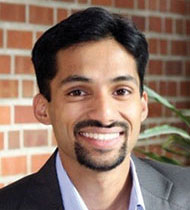Arun Devaraj (PhD 2011)

Hometown:
Kannur, Kerala, India
Current Position:
Senior Research Scientist, Pacific Northwest National Laboratory, Richland, Washington
Interesting Experience:
My Ph.D. research at UNT was focused on microstructural evolution in titanium alloys.
Once I moved to PNNL in 2011, I was involved in many other research areas ranging
from nuclear reactor structural materials, battery electrode materials, magnetic materials,
catalysts, advanced microstructural characterization by Atom Probe tomography, etc.,
all with a focus on understanding microstructure-property relationships. Although
I enjoyed all these new areas of research, deep inside I still loved my research in
Titanium (Ti) alloys, and I wasn’t sure if anyone at PNNL worked in this area. Then
one day, during a casual meeting in one of the labs in PNNL, one of my colleagues
from another PNNL directorate mentioned that he is working on a new, low-cost Ti alloy
production method with a senior scientist who had been working with industries on
Ti alloys for more than 15 years. That sparked my enthusiasm, and after meeting the
senior scientist, he was also excited to know that there is a PNNL researcher with
background in fundamental physical metallurgy of beta Ti alloys. That discussion led
to start of a small research collaboration between us, which I completed successfully
and gave a clear explanation on why the alloy they made had a very high strength based
on a unique microstructure it had. In 2016, I published the results in Nature Communications,
which truly was one of the most enjoyable moments of my career, because I was able
to make a meaningful contribution to the field in which I did my PhD. Also, that research
interaction led to several research collaborations between me and that group of researchers,
to an extent that now, a major portion of my research time is dedicated to developing
advanced high performance light weight structural alloys with novel processing methods.
How did your time at UNT help you with your career:
Once I was at UNT doing my Ph.D., I was introduced to the fascinating world of the
microstructure of metallic materials. I could study how heating and cooling an alloy
to different temperatures and time leads to different types of phase transformations
that influences the development of final microstructure of the alloy. Additionally,
I learned the power of many advanced microscopy and diffraction methods that I can
use, including electron microscopes, x-ray diffraction, atom probe tomography etc.,
to see how atoms get rearranged in materials when they undergo phase transformations.
Also, through my Ph.D. co-advisor, I learned the power of first principle computation
methods in providing complementary information to what we see using microscopy methods.
Once I finished my Ph.D. and moved to this new organization, my daily work is still
strongly rooted in these fundamentals I learned from my time at UNT; the only change
is that I now study a much broader list of material systems, and in addition to heating
and cooling materials to different times, I now also look at how radiation, electric
fields, high shear stress or chemical reactions modify the microstructure of materials
changing their mechanical, physical or chemical properties and then propose solutions
to make materials resistant to such changes. To summarize, although my research areas
have become much broader, the fundamentals I learned during my Ph.D. have been directly
beneficial for every day of my career.